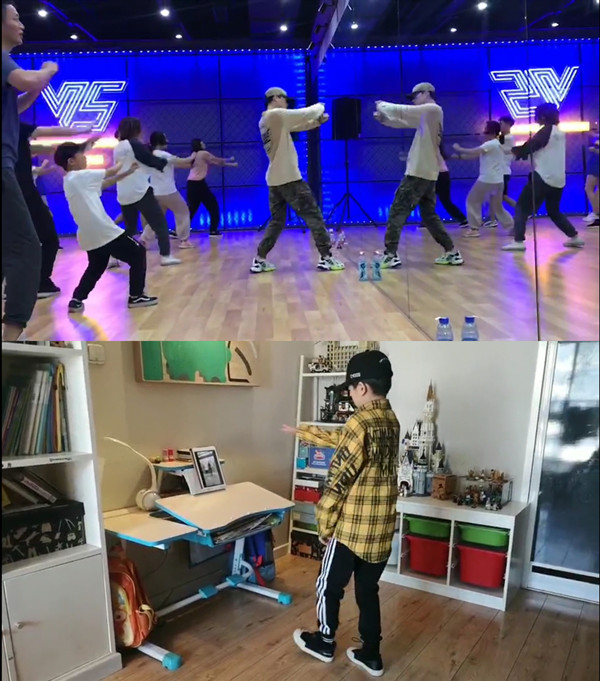From ballroom to living room: Dance studios turn to live-streaming amid COVID-19
- By Wang Yiming
 0 Comment(s)
0 Comment(s) Print
Print E-mail China.org.cn, March 31, 2020
E-mail China.org.cn, March 31, 2020

Eight-year-old Deng Minchuan has been learning street dance for three years. Due to COVID-19, V5 Dance Studio, a Beijing-based studio where he takes classes, was forced to temporarily close and move their lessons online. Quarantined at home since February, Deng continues to learn routines via live-streamed classes.
"Anyway, under the current situation, he has no choice but to take classes online at home," Deng Minchuan's mother told China.org.cn. "Although the interaction with teachers and the dancing atmosphere can't compare to the studio, it saves time since we don't need to travel there, and he can playback the tutorials and keep practicing the parts he doesn't figure out during the live-stream."
According to QuestMobile, a big data service provider, the amount of time Chinese people spend on the mobile internet increased by 21.5% over the the past two months since the outbreak, with video apps accounting for a significant part of the rise.
Many businesses facing challenging times during the epidemic are turning to live-streaming to offset financial losses. Even dance studios,which depend largely on physical interaction, have taken to live-streaming as an effective stopgap measure.
From Douyin, the Chinese counterpart to TikTok, to all kinds of professional live video streaming apps, dance studios are learning to embrace the digital world.
"Our members have been self-isolating at home since the end of January due to the epidemic," explained Ray, a dancer and instructor at V5 Dance Studio. "They said that they were bored and wanted to dance. After discussion, we decided to live-stream classes so that the students could dance along with us from home."
He added, "At first, we offered live dance classes for free on Douyin. After a week-long trial, we switched to professional live-streaming software and started paid courses."

Compared with its previous price of 100 yuan per session, the online classes at V5 Dance Studio cost only 268 yuan for 26 sessions. But without the size limitations of a studio, the virtual classes have attracted many more students.
In fact, online dance classes are nothing new. Long before the recent boom in online classes, some studios started selling pre-recorded dance tutorials for those unable to make it to a dance studio. But this kind of online course was only on a small scale.
"There are some similarities between the pre-recorded tutorials and teaching via live-stream. But the main difference lies in the real-time interaction. I can respond to their questions live in class," Ray explained. During his eight years of teaching, he has never live-streamed classes before and only recorded videos a few times.
Similar to V5 Dance Studio, Smile Dance Studio in Chengdu, Sichuan province, also responded to COVID-19 by live-streaming on Douyin. They have kept offering free daily classes since February.
"2020 was supposed to be a good year for pop dance studios and the winter holiday is usually peak season," Wang Quan, owner of Smile Dance Studio, told China.org.cn. "We'd prepared a lot for the courses, but in the end we lost the whole season. All the classes were called off and we refunded some members."
"After canceling the previous sessions, we followed suit hosting live dance classes online. Our dance instructors offered free tutorials at 8 p.m. every day via Douyin, attracting an average of over 2,000 viewers each night. Total views have now exceeded 100,000. For these online followers, our would-be customers, we tried to maintain contact with them by also creating WeChat groups."

Wang noted that the majority of live-streaming videos for dance studios are still tutorials, so donations or tips from viewers are minimal.
"The ideal way to monetize is to provide high-quality paid online classes after we promote our brand and attract enough loyal followers by giving free sessions," Wang said.
As the epidemic situation in China continues to improve, Smile Dance Studio is preparing both to reopen and offer paid online classes. "Based on our recent experience, we're putting together a series of online classes for between just 9.9 yuan and 19.9 yuan per lesson, " explained Wang.
Speaking of the future of online dance classes, Wang believes that they will be an important part of their business, but the difficulty lies in studios being able to carve out their own niche and integrate both online and offline sessions.
"Compared to other types of online education, dancing is more special because it requires an atmosphere and keeping members physically engaged," explained Wang." The epidemic has given dance studios a chance to test the waters and let more people try out this kind of online class. Objectively, it may speed up the future trend of integrating online and offline dance lessons."






Go to Forum >>0 Comment(s)